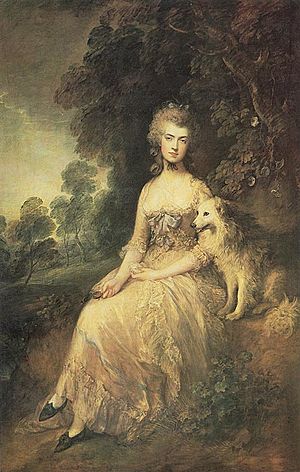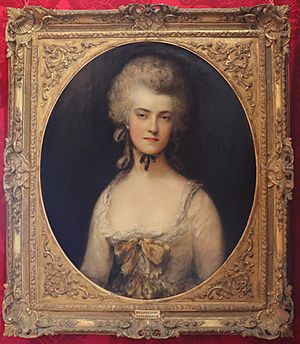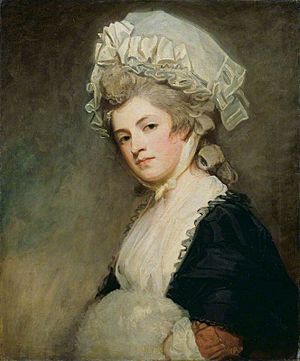Mary Robinson (poet) facts for kids
Quick facts for kids
Mary Robinson
|
|
|---|---|

Portrait of Mary Robinson by Thomas Gainsborough, 1781
|
|
| Born |
Mary Darby
27 November 1757 Bristol, England
|
| Died | 26 December 1800 (aged 43) Englefield Green, England
|
| Spouse(s) | Thomas Robinson |
| Children | Mary Elizabeth Robinson |
Mary Robinson (born Mary Darby; 27 November 1757 – 26 December 1800) was a famous English actress, poet, and writer. She was also a well-known public figure. Mary lived in England, including Bristol and London. She also spent some time in France and Germany.
Mary loved poetry from a young age. She started working at 14, first as a teacher and then as an actress. She wrote many plays, poems, and novels. She was so famous that newspapers often wrote about her. People knew her for her amazing acting and writing. During her life, she was called "the English Sappho" because of her beautiful poetry. She earned the nickname "Perdita" in 1779. This was for her role as Perdita, a character in Shakespeare's play The Winter's Tale.
Contents
Mary Robinson's Life Story
Her Early Years
Mary Robinson was born in Bristol, England. Her father, Nicholas Darby, was a naval captain. Her mother was Hester Vanacott. Mary was born on November 27, 1757.
When Mary was a child, her father left her mother. He started a new family. Without her husband's help, Mary's mother, Hester, had to support her five children. She opened a school for young girls in Little Chelsea, London. Mary helped teach at this school by the time she was 14. However, her father briefly returned and closed the school. This was allowed by English law at the time.
Mary later attended a school run by Hannah More, a social reformer. It was there that she caught the attention of the famous actor David Garrick.
Her Marriage and Challenges
Mary's mother wanted her to marry Thomas Robinson. He was a law student who claimed to have a large inheritance. Mary was not sure about this idea. But after she became ill, Thomas took care of her. She felt she owed him and did not want to upset her mother. So, she agreed to marry him.
After their marriage, Mary found out Thomas had no inheritance. He still spent a lot of money and had many affairs. Mary had to support their family. When Thomas spent all their money, they had to flee to Talgarth, Breconshire. Their only daughter, Mary Elizabeth, was born there.
Eventually, Thomas was sent to Fleet Prison for his debts. Mary and their 6-month-old baby lived with him in prison for many months. It was common for wives to live with their husbands in prison. But children were usually sent to relatives. Mary was very devoted to her daughter and kept her close.
While in prison, Mary's writing career truly began. She found she could publish poetry to earn money. It also gave her a way to escape the difficult prison life. Her first book, Poems By Mrs. Robinson, was published in 1775. Mary's husband was offered work copying legal papers. But he refused to do it. Mary took on this job herself to help her family. During this time, Mary found a supporter in Georgiana Cavendish, Duchess of Devonshire. The Duchess helped publish Mary's second book of poems, Captivity.
Her Acting Career
After her husband was released from prison, Mary decided to return to the theatre. She began her acting career at the Drury Lane Theatre in December 1776. She was very good at playing "breeches parts." These were roles where women dressed as men. Her performances in Shakespeare's Twelfth Night and As You Like It were highly praised.
Mary became very popular for her role as Perdita in Florizel and Perdita. This play was an adaptation of Shakespeare's The Winter's Tale. It was during this performance in 1779 that she caught the eye of the young Prince of Wales. He later became King George IV.
Mary became a fashion trendsetter in London. She introduced a loose, flowing style of dress. It was inspired by ancient Greek statues. This style became known as the "Perdita" dress. The Prince of Wales ended their relationship in 1781. Mary then had to support herself through her writings. She also received some money from the Crown, though it was not always paid. After her time with the Prince, she became famous for her fancy carriages. She was seen as a true celebrity by the public.
Later Life and Legacy
In 1783, Mary suffered an illness that left her partly paralyzed. Despite this, she continued to write.
From the late 1780s, Mary became famous for her poetry. People started calling her "the English Sappho." Besides poems, she wrote eight novels and three plays. She also wrote essays about women's rights. She was a strong supporter of women's equality. She also supported the French Revolution.
Mary died in Englefield Green, England, on December 26, 1800. She was 44 years old and had been ill for many years. Her daughter, Maria Elizabeth, also became a published writer. One of Mary's last wishes was for her daughter to publish her remaining works. Maria published Mary's Memoirs just a few months after her death.
Famous Portraits
Many famous artists painted Mary Robinson during her lifetime. These portraits showed her beauty and fame. In 1781, Thomas Gainsborough painted her. George Romney also painted her around 1782. Joshua Reynolds created several portraits of her, including one in 1782. These paintings helped to capture her image for future generations.
Mary Robinson's Writings

In 1792, Mary Robinson published her most popular novel, Vancenza; or The Dangers of Credulity. This Gothic novel was a huge success. It sold out on its first day! Five more editions quickly followed. This made it one of the best-selling novels of the late 1700s.
She also wrote The Widow; or, A Picture of Modern Times in 1794. This novel looked at the manners of the fashionable world. In 1796, she wrote Angelina: A Novel.
Recently, more scholars have been studying Mary Robinson's writings. Her complete works were published in an eight-volume set between 2009 and 2010. Experts have also written books about her poetry and how she influenced the Romantic era of literature.
Mary Robinson was praised for her poetry and her prose. Two of her well-known prose works are "A Letter to the Women of England" (1798) and "The Natural Daughter" (1799). Both of these works discuss the role of women during the Romantic Era. Mary Robinson, like Mary Wollstonecraft, wanted to highlight how women were treated unfairly compared to men. "The Natural Daughter" is seen as a story based on Mary Robinson's own life.
Her Poetry

From the late 1780s, Mary focused on writing full-time. She wanted to move past her past fame as an actress. She became known as "the English Sappho" for her beautiful poems.
Mary wrote a lot during her 25-year career, from 1775 until her death in 1800. She published eight collections of poems. She also wrote eight novels, three plays, and essays about women's rights. She even started an autobiography, but it was not finished when she died.
Her first book, Poems by Mrs. Robinson, came out in 1775. It had 26 poems that praised values like kindness and innocence. Mary hoped the money from this book would help pay her husband's gambling debts. But it was not enough, and he was still sent to prison. Mary and her baby lived with him there for nine months.
Her time in prison inspired her next work, Captivity; a Poem, published in 1777. This collection described the sadness of being held captive. It asked people to feel pity for those who were suffering.
Mary continued to develop her poetic style. She published Poems by Mary Robinson in 1791 and another collection in 1793. Reviewers praised her poetry as "elegant and harmonious."
In 1795, Mary wrote a poem called London's Summer Morning. It was published after her death in 1800. This poem showed her thoughts on London's busy city life. She described the sounds of the industrial city. She also used characters like the chimney-boy to comment on how English society treated children.
In 1796, Mary wrote Sappho and Phaon: In a Series of Legitimate Sonnets. In this work, she argued for women's intelligence and their right to education. She was very inspired by feminism in the 1790s. She admired Mary Wollstonecraft, another important feminist writer of that time.

In 1800, after years of poor health and financial struggles, Mary wrote her last book of poems. It was called Lyrical Tales.
Mary Robinson's Works

Poetry
- Poems by Mrs. Robinson (London: C. Parker, 1775) Digital Edition
- Captivity, a Poem and Celadon and Lydia, a Tale. Dedicated, by Permission, to Her Grace the Duchess of Devonshire. (London: T. Becket, 1777)
- Ainsi va le Monde, a Poem. Inscribed to Robert Merry, Esq. A.M. [Laura Maria] (London: John Bell, 1790)
- Poems by Mrs. M. Robinson (London: J. Bell, 1791)
- The Beauties of Mrs. Robinson (London: H. D. Symonds, 1791)
- Monody to the Memory of Sir Joshua Reynolds, Late President of the Royal Academy, &c. &c. &c. (London: J. Bell, 1792)
- Ode to the Harp of the Late Accomplished and Amiable Louisa Hanway (London: John Bell, 1793)
- Modern Manners, a Poem. In Two Cantos. By Horace Juvenal (London: Printed for the Author, 1793)
- Sight, the Cavern of Woe, and Solitude. Poems (London: T. Spilsbury and Son, 1793)
- Monody to the Memory of the Late Queen of France (London: T. Spilsbury and Son, 1793)
- Poems by Mrs. M. Robinson. Volume the Second (London: T. Spilsbury and Son, 1793)
- Poems, by Mrs. Mary Robinson. A New Edition (London: T. Spilsbury, 1795)
- Sappho and Phaon. In a Series of Legitimate Sonnets, with Thoughts on Poetical Subjects, and Anecdotes of the Grecian Poetess (London: For the Author, 1796)
- Lyrical Tales, by Mrs. Mary Robinson (London: T. N. Longman and O. Rees, 1800) Digital Edition
- The Mistletoe. --- A Christmas Tale [Laura Maria] (London: Laurie & Whittle, 1800)
Novels
- Vancenza; or, the Dangers of Credulity. In Two Volumes (London: Printed for the Authoress, 1792)
- The Widow, or a Picture of Modern Times. A Novel, in a Series of Letters, in Two Volumes (London: Hookham and Carpenter, 1794)
- Angelina; a Novel, in Three Volumes (London: Printed for the Author, 1796)
- Hubert de Sevrac, a Romance, of the Eighteenth Century (London: Printed for the Author, 1796)
- Walsingham; or, the Pupil of Nature. A Domestic Story (London: T. N. Longman, 1797)
- The False Friend: a Domestic Story (London: T. N. Longman and O. Rees, 1799)
- Natural Daughter. With Portraits of the Leadenhead Family]. A Novel (London: T. N. Longman and O. Rees, 1799)
Dramas
- The Lucky Escape, A Comic Opera (performed on 23 April 1778 at the Theatre Royal, Drury Lane)
- The Songs, Chorusses, &c. in The Lucky Escape, a Comic Opera, as Performed at the Theatre-Royal, in Drury-Lane (London: Printed for the Author, 1778)
- Kate of Aberdeen (a comic opera withdrawn in 1793 and never staged)
- Nobody. A Comedy in Two Acts (performed on 27 Nov. 1794 at the Theatre Royal, Drury Lane) Digital Edition
- The Sicilian Lover. A Tragedy. In Five Acts (London: Printed for the Author, 1796)
Political Treatises
- Impartial Reflections on the Present Situation of the Queen of France; by A Friend to Humanity (London: John Bell, 1791)
- A Letter to the Women of England, on the Injustice of Mental Subordination. With Anecdotes. By Anne Frances Randall] (London: T. N. Longman and O. Rees, 1799)
- Thoughts on the Condition of Women, and on the Injustice of Mental Subordination (London: T. N. Longman and O. Rees, 1799)
Essays
- “The Sylphid. No. I,” Morning Post and Gazetteer 29 Oct. 1799: 2 (also printed in Memoirs 3: 3–8)
- “The Sylphid. No. II,” Morning Post and Gazetteer 7 Nov. 1799: 2 (also printed in Memoirs 3: 8–16)
- “The Sylphid. No. III,” Morning Post and Gazetteer 16 Nov. 1799: 3 (also printed in Memoirs 3: 17–21)
- “The Sylphid. No. IV,” Morning Post and Gazetteer 23 Nov. 1799: 2 (edited version printed in Memoirs 3: 21–26)
- “The Sylphid. No. V,” Morning Post and Gazetteer 27 Nov. 1799: 2 (also printed in Memoirs 3: 27–31)
- “The Sylphid. No. VI,” Morning Post and Gazetteer 7 Dec. 1799: 2 (edited version printed in Memoirs 3: 31–35)
- “The Sylphid. No. VII,” Morning Post and Gazetteer 19 Dec. 1799: 2 (also printed in Memoirs 3: 35–40)
- “The Sylphid. No. VIII,” Morning Post and Gazetteer 24 Dec. 1799: 2 (also printed in Memoirs 3: 41–45)
- “The Sylphid. No. IX,” Morning Post and Gazetteer 2 Jan. 1800: 3 (also printed as No. XIV in Memoirs 3: 74–80)
- “To the Sylphid,” Morning Post and Gazetteer 4 Jan. 1800: 3 (also printed as No. IX in Memoirs 3: 46–50)
- “The Sylphid. No. X,” Morning Post and Gazetteer 7 Jan. 1800: 3 (also printed in Memoirs 3: 51–57)
- “The Sylphid. No. XI,” Morning Post and Gazetteer 11 Jan. 1800: 2 (also printed in Memoirs 3: 58–63)
- “The Sylphid. No. XII,” Morning Post and Gazetteer 31 Jan. 1800: 2 (edited version printed in Memoirs 3: 63–68)
- “The Sylphid. No. XIII,” Memoirs 3: 68-73 (no extant copy of Morning Post exists)
- “Present State of the Manners, Society, &c. &c. of the Metropolis of England,” Monthly Magazine 10 (Aug. 1800): 35–38.
- “Present State of the Manners, Society, &c. &c. of the Metropolis of England,” Monthly Magazine 10 (Sept. 1800): 138-40
- “Present State of the Manners, Society, &c. &c. of the Metropolis of England,” Monthly Magazine 10 (Oct. 1800): 218-22
- “Present State of the Manners, Society, &c. &c. of the Metropolis of England,” Monthly Magazine 10 (Oct. 1800): 305-06
Translation
- Picture of Palermo by Dr. Hager translated from the German by Mrs. Mary Robinson (London: R. Phillips, 1800)
Biographical Sketches
- “Anecdotes of Eminent Persons: Memoirs of the Late Duc de Biron,” Monthly Magazine 9 (Feb.1800): 43-46
- “Anecdotes of Eminent Persons: Account of Rev. John Parkhurst,” Monthly Magazine 9 (July 1800): 560-61
- “Anecdotes of Eminent Persons: Account of Bishop Parkhurst,” Monthly Magazine 9 (July 1800): 561
- “Anecdotes of Eminent Persons: Additional Anecdotes of Philip Egalité Late Duke of Orleans,” Monthly Magazine 10 (Aug. 1800): 39-40
- “Anecdotes of Eminent Persons: Anecdotes of the Late Queen of France,” Monthly Magazine 10 (Aug. 1800): 40-41
Posthumous Publications
- “Mr. Robert Ker Porter.” Public Characters of 1800-1801 (London: R. Phillips, 1801)
- Memoirs of the Late Mrs. Robinson, Written by Herself with Some Posthumous Pieces. In Four Volumes (London: R. Phillips, 1801)
- “Jasper. A Fragment,” Memoirs of the Late Mrs. Robinson, Vol. 3 (London: R. Phillips, 1801)
- “The Savage of Aveyron,” Memoirs of the Late Mrs. Robinson, Vol. 3 (London: R. Phillips, 1801)
- “The Progress of Liberty,” Memoirs of the Late Mrs. Robinson, Vol. 4 (London: R. Phillips, 1801)
- The Poetical Works of the Late Mrs. Mary Robinson: Including Many Pieces Never Before Published. In Three Volumes (London: Richard Phillips, 1806)

